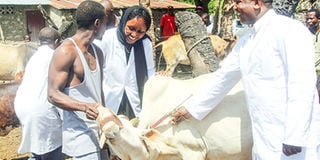Breaking News: At least 10 feared to have drowned in Makueni river
Amend Vet Act to improve livestock sector

Mombasa County executive in-charge of livestock and fisheries, Binti Omar looks on as Dr Philip Okiya vaccinates a cow against foot and mouth disease in the past. PHOTO | FILE | NATION MEDIA GROUP
What you need to know:
- The sub-sector contributes a tenth of the national gross domestic product and about 42 per cent of the agricultural GDP.
- The amendment would allow community-based animal health workers to act as first responders given the low number of veterinarians against the livestock population in pastoral counties.
- Inspection of animal drugs by veterinary personnel is limited by the law that puts the inspectorate under the Health ministry vide the Pharmacy and Poisons Act.
Pressure for liberalisation and privatisation of the market has seen provision of government services to livestock keepers in the arid and semi-arid lands (ASALs) reduced or withdrawn and attempts made to push them to the private sector. But that has not picked due to poor infrastructure and vastness of the Asals and natural disasters such as drought and famine.
More than 60 per cent of the country’s livestock is reared in the ASAL counties, employing 90 per cent of the local population. The sub-sector contributes a tenth of the national gross domestic product and about 42 per cent of the agricultural GDP.
It also supplies the domestic demand for meat, milk and dairy products and other livestock products while accounting for about 30 per cent of the marketed agricultural products. This is besides bringing in substantial foreign exchange through the export of live animals, hides and skins.
SUBSTANCIAL INCOME
The sub-sector employs half of the agricultural sector labour-force and gives households substantial income from sale of livestock and livestock products while providing raw material for agro-industries.
Its true contribution to the economy could be higher if unrecorded slaughter and home consumption were considered.
Future demand for red meat will depend on the overall trend of economic development, mainly the overall macro-economic growth in the key sectors of economy. To also stimulate beef production are more effective disease control as abuse and misuse of veterinary drugs exposes consumers of animal products to risk, and improved infrastructure.
The government should separate management of veterinary drugs from that of human medicines and move control of the regulation of veterinary drugs to the ministry in charge of livestock affairs.
Parliament should quickly enact the Veterinary Surgeons and Veterinary Para-professionals Act 2011 (Vet Act) for clear distinction of roles.
According to the National Livestock Policy 2008, the government is constrained by both low numbers of skilled personnel and limited facilities, which impede capability to monitor prevalence of diseases and pests, especially in ASALs.
DEVOLVED
The amendment would allow community-based animal health workers (CBAHWs) to act as first responders given the low number of veterinarians against the livestock population in pastoral counties.
Livestock farmers have lost a substantial number of animals over the years as the Vet Act barred CBAHWs — who have been in the forefront in livestock treatment and vaccination — from treating livestock and relegated them to the role of disease reporters. Some of them happen to be livestock farmers.
Inspection of animal drugs by veterinary personnel is limited by the law that puts the inspectorate under the Health ministry vide the Pharmacy and Poisons Act. This leads to sale of veterinary drugs in the wrong places with no prescription.
Lastly, the Kenya Veterinary Board (KVB) lacks balance as private universities are not represented. Of the 17 available slots, private institutions have only three. Also include ASAL county governments and other stakeholders in the board since agriculture is devolved.
Mr Adankhalif is a disaster, risk and policy consultant. [email protected].





